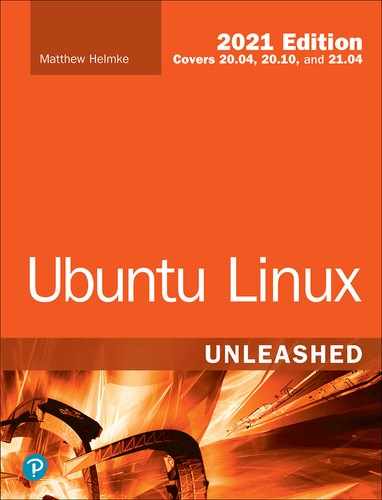Book Description
Covers 20.04, 20.10, and 21.04
Ubuntu Linux Unleashed 2021 Edition is filled with unique and advanced information for everyone who wants to make the most of the Ubuntu Linux operating system. This new edition has been thoroughly updated by a long-time Ubuntu user and early community leader to reflect the exciting new Ubuntu 20.04 LTS release, with a forthcoming online update mid-2021, at the halfway mark before the next LTS release comes out.
Linux writer Matthew Helmke covers all you need to know about Ubuntu 20.04 LTS installation, configuration, productivity, command-line usage, development, systems administration, server operations, networking, virtualization, cloud computing, DevOps, and moreincluding intermediate-to-advanced techniques you wont find in any other book.
Helmke presents up-to-the-minute introductions to Ubuntus key productivity and web development tools, programming languages, hardware support, and more. Youll find new or improved coverage of the Ubuntu desktop experience, common web servers and software stacks, an introduction to containers like Docker and Kubernetes, as well as a wealth of systems administration information that is stable and valuable over many years.
Configure and use the Ubuntu desktop
Get started with multimedia and productivity applications
Manage Linux services, users, and software packages
Administer and run Ubuntu from the command line
Automate tasks and use shell scripting
Provide secure remote access and configure a secure VPN
Manage kernels and modules
Administer file, print, email, proxy, LDAP, DNS, and HTTP servers (Apache, Nginx, or alternatives)
Work with databases (SQL) and learn about NoSQL alternatives
Get started with virtualization and cloud deployment, including information about containers
Learn about options for managing large numbers of servers, including in the cloud
Learn the basics about popular programming languages including Python, PHP, Perl, and gain an introduction to new alternatives such as Go and Rust
Table of Contents
- Cover Page
- About This eBook
- Title Page
- Copyright Page
- Contents at a Glance
- Table of Contents
- About the Authors
- Dedication
- Acknowledgments
- Register Your Book
- Figure Credits
- Introduction
- Part I: Getting Started
- Part II: Desktop Ubuntu
- Part III: System Administration
- Chapter 9. Managing Software
- Chapter 10. Command-Line Beginner’s Class
- Chapter 11. Command-Line Master Class, Part 1
- Chapter 12. Command-Line Master Class, Part 2
- Redirecting Output and Input
- stdin, stdout, stderr, and Redirection
- Comparing Files
- Limiting Resource Use and Job Control
- Combining Commands
- Executing Jobs in Parallel
- Using Environment Variables
- Using Common Text Editors
- Working with Compressed Files
- Using Multiple Terminals with byobu
- Doing a Polite System Reset Using REISUB
- Fixing an Ubuntu System That Will Not Boot
- Tips and Tricks
- References
- Chapter 13. Managing Users
- Chapter 14. Automating Tasks and Shell Scripting
- Chapter 15. The Boot Process
- Chapter 16. System-Monitoring Tools
- Chapter 17. Backing Up
- Chapter 18. Networking
- Laying the Foundation: The localhost Interface
- Checking Connections with ping, traceroute, and mtr
- Networking with TCP/IP
- IPv6 Basics
- Network Organization
- Hardware Devices for Networking
- Using Network Configuration Tools
- Dynamic Host Configuration Protocol
- Wireless Networking
- Beyond the Network and onto the Internet
- Common Configuration Information
- References
- Chapter 19. Remote Access with SSH and VNC
- Chapter 20. Securing Your Machines
- Chapter 21. Performance Tuning
- Chapter 22. Kernel and Module Management
- Part IV: Ubuntu as a Server
- Chapter 23. Sharing Files and Printers
- Chapter 24. Common Web Server Stacks
- Chapter 25. Apache Web Server Management
- Chapter 26. Nginx Web Server Management
- Chapter 27. Other HTTP Servers
- Chapter 28. Administering Relational Database Services
- Chapter 29. NoSQL Databases
- Chapter 30. Virtualization on Ubuntu
- Chapter 31. Containers and Ubuntu
- Chapter 32. Ubuntu and Cloud Computing
- Chapter 33. Managing Sets of Servers
- Chapter 34. Handling Email
- Chapter 35. Proxying, Reverse Proxying, and Virtual Private Networks (VPNs)
- Chapter 36. Lightweight Directory Access Protocol (LDAP)
- Chapter 37. Name Serving with the Domain Name System (DNS)
- Part V: Programming Linux
- Chapter 38. Using Programming Tools
- Programming in C with Linux
- Using the C Programming Project Management Tools Provided with Ubuntu
- Using the GNU C Compiler
- Programming in Java with Linux
- Graphical Development Tools
- Beginning Mobile Development for Android
- Version Control Systems
- Continuous Integration and Continuous Delivery and DevOps Tools
- Canonical-created Tools
- References
- Chapter 39. Using Popular Programming Languages
- Chapter 40. Helping with Ubuntu Development
- Chapter 41. Helping with Ubuntu Testing and QA
- Chapter 38. Using Programming Tools
- Index
- Part VI: Bonus Online Chapters
- Code Snippets
